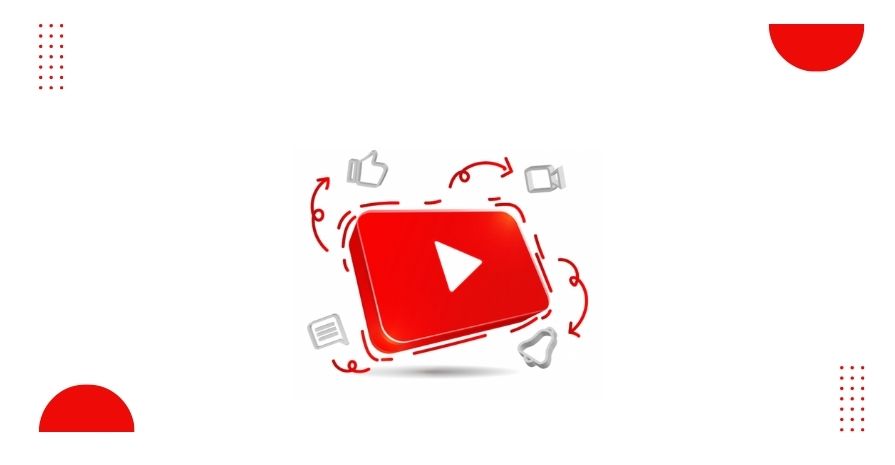If you haven’t started cashing in on the video content yet, that means you’re leaving money on the table.
If you’re a brand and haven’t figured out YouTube yet, you’re at the right place and now you can start on the right foot.
A lot of brands haven’t even started paying close attention to content marketing, let alone building a YouTube strategy for definite video marketing.
Therefore, I decided to dig deeper into this topic to help guide brands in establishing a YouTube strategy.
If you’re wondering, why you should listen to me, then I have some explanation for this, after all.
One of my YouTube channels is about to reach 10k subscribers. On the other hand, I have a video with over 100k views on my second YouTube channel. Sure, these numbers aren’t gigantic, but over the past few years, I’ve learned so much about YouTube growth via content creation. That’s why I’ll be able to share some value to navigate you in the right direction.
Sounds good?
I’ll surely share some steps that you can follow along for YouTube growth, but there is a caveat: everything doesn’t work for everyone.
Here’s a YouTube success secret right off the bat: The more you experiment, the more you get closer to success.
So don’t get demotivated if PLAN A doesn’t work out for you as you can make a tweak and it becomes the PLAN B.
And guess what, the list goes on until you hit the sweet spot.
Related: Cracking YouTube Algorithm in 2022: A Marketer’s Guide
Before we move to YouTube strategy building, here are three essential elements of establishing a successful YouTube strategy.
Essential Elements of Establishing a Successful YouTube Strategy
-
Experimentation
A successful YouTube strategy can’t be built on a whim, instead, it takes some time. When you keep the experimentation mindset, you’ll be open to new experiences, which could turn things around for you. Think out of the box and don’t be afraid of failures.
It’s also important to understand what I mean by experimentation on YouTube: it means that you should try out different video formats, video lengths, thumbnails and titles, and playlists to understand what your audience likes the most and what you also enjoy doing it.
-
Consistency
You must have heard that consistency is the key to success. It’s kind of true, though. People often ask me how I keep going on YouTube, and I keep on telling them that I enjoy doing it. I have been making YouTube videos for almost 4 years, and I still love it. It looks like a simple phenomenon on the outside, but on the inside, it does make a lot of difference.
It’s difficult to keep up if you aren’t having fun in the process. So you might be wondering, what’s the secret sauce of having fun at work? The answer is that if you choose the right niche and content type to make content, you won’t get frustrated, and as a result, you won’t have inconsistency issues. The easiest way to find out whether or not you chose the right niche is by seeing how excited you’re to make new content.
-
Collaboration
Collaboration is a vital ingredient of the YouTube success recipe. You’d always find top YouTubers collaborating with other YouTubers. The reason is that collaboration is a globally-accepted Youtube growth and social media growth hack. Plus, on YouTube, it works incredibly well.
How would you collaborate with other YouTubers? You might be wondering, right now. The simple answer to this question is that you find relevant YouTube channels, consume their content, engage with them through commenting, liking and sharing, and connect with those creators on all social media networks.
This way, you’d be able to stand out from the rest of the subscribers’ base. Once you establish your relationship with a creator, pitch your idea, and see what happens. Make sure that you’re highlighting the other creator and making an interesting video.
A successful collaboration strategy works both ways. If you just target to get subscribers from other creators through the collaborations, it won’t interest other creators. Come up with a strategy that brings attention and value to other creators more than it brings to you.
So these were three key elements of getting started and growing on YouTube.
Now you need a step-by-step guideline to get going.
A 7-Step Process of Building a YouTube Strategy for Brands
Let’s take a look at the steps that are required to build a YouTube strategy for brands:
1. Identify the Target Audience
If you pay close attention to YouTube, most creators who succeed are either who are consistent or those who are extremely creative in their craft.
When it comes to brands, it gets slightly more difficult than individual creators. The trickiest part in building a YouTube strategy for brands is that where to begin from in the process, and that’s where step #1 comes in, which is identifying the target audience.
It all begins from figuring out who the right people are that should watch your content on YouTube. Once you have a persona in mind, it shapes the way you create content for them.
Therefore, the identification of the target audience is extremely important in the YouTube strategy.
The question that arises now is how one can define their target audience.
The following three factors can help us identify the target audience:
i) Value Proposition
The value proposition is a strength that puts a brand on a pedestal. It’s something that gives a brand or an individual a competitive edge over the competition. So a value proposition could lead a brand towards a new segment of the market. When it comes to establishing a YouTube strategy, one can utilize the value proposition to create video content that attracts the eyeballs around and help a brand dominate the market.
ii) Product or Service
A company’s product is a big deal when it comes to creating content. Product awareness could contribute to developing high-quality content, which may end up finding prospective clients or new subscribers.
Try to sell your expertise, knowledge, and product awareness in the videos. People are striving to find free information and resources, and the opportunity to attract the audience is humongous.
iii) Existing Fan Base
If you’re getting started with YouTube and want to build a YouTube strategy, then the chances are, you have an existing audience whether it is an email list or Facebook followers. You can always go through your email newsletter content strategies and engagement tactics to navigate for building a YouTube strategy. The existing fan base can direct you towards finding a like-minded audience on YouTube.
The video team at ContentStudio knows about the potential customers and target audience. Therefore, they’re quite focused on reaching out to the right audience through creating relevant content on the YouTube channel:
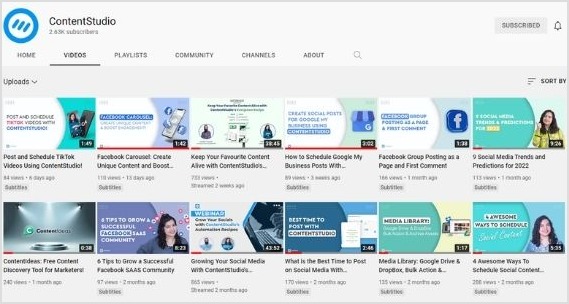
The key to reaching the target audience is essentially experimentation with the content.
You may not instantly find the most loyal audience once you start to put out content on YouTube, but eventually, as the time passes, you’d get to know what the audience wants from you.
Your content performance would essentially tell you a lot about the demand of the audience and type of audience you can amass. Read step #2 for more details on the content planning for building a YouTube strategy.
2. Map out the Content Plan
The video content is essentially the meat of the YouTube strategy. Every aspect of building the video content plan impacts the outcome of the overall YouTube strategy. Therefore, mapping out the content plan is essentially doing the ground-work for the video creation process.
It’s important to understand who you should be making videos for as discussed in the step #1, once you’ve figured that out, you’re all set to work on the content plan for your YouTube channel.
A content planner for YouTube encapsulates the niche you’re in, the playlists you build, and the content categories you choose to put out content on YouTube.
Furthermore, you can’t exclude the video titles selection and thumbnail designing from the YouTube content plan. Therefore, pay attention to the whole content mix.
Here are five steps of mapping out the YouTube content plan:
i) Build a Viewer Persona
First things first, create a viewer persona, which compasses the nitty-gritty of the potential audience you need. It’s far better than creating random videos without a clear audience in mind. A lot of YouTubers don’t niche down their audience and end up making average YouTube channels. So don’t hesitate to identify the audience so that you could make videos for the right audience.
ii) Create a List of Playlists
YouTube playlists are widely underrated; you’d always hear YouTube gurus talk about the keyword research, thumbnails, and topic selection, but a few talk about choosing the playlist. It’s essential to have specific playlists on the YouTube channel so that the YouTube search system could understand your content type and showcase your videos in the search.
iii) Choose the Video Topics
The selection of the right video topics is crucial to a successful YouTube strategy. Choose the video topics that are relevant to your niche and people are interested in the topics. One of the best ways to choose the video topics is by listening to your audience through comments, DMs, and emails.
iv) Make Videos in Bulk
The batch recording is quite a norm among YouTube creators. Sure, some channels might not be able to pull this off, but most of the channels can do this. It’s one of the easiest ways to get consistent with uploads on YouTube.
A lot of YouTubers record batch videos so that they don’t have to go through the recording phase over and over again. So don’t overlook this content development hack.
v) Post Videos on a Schedule
A posting schedule may seem like a difficult task, but it’s worth it. Once you get into the groove, it becomes so beneficial as it sends out a message to the subscribers that a video would come out on a specific day or time. The followers start to expect the videos once you become consistent with your scheduling. You can use any of the social media management tools for frequent scheduling and posting to your YouTube.
Creating a content plan does look like a difficult job, but if you have figured out the niche and you’re passionate about YouTube, you’re all set to make an impact.
3. Leverage YouTube Shorts
Short videos are becoming more popular. This is because they are more appealing to the audience and can be consumed quickly. They are also less expensive to produce than a full-length film.
The strategy behind posting short videos on YouTube is to create content that will go viral. The more views it gets, the more people will be exposed to your brand.
Posting YouTube Shorts is an excellent way to build an audience on YouTube, but it is not easy to execute. It requires a lot of planning and execution from the video creators.
It is important to have a strategy when posting these short videos. This strategy should include what type of video you will be posting, the length of the video, and what the video will be about.
You don’t always have to create a new short video from scratch for YouTube shorts as you can cut compelling short clips from your already existing long videos.
In the next step, I’ll share the SEO tactics that could turn things around for your YouTube channel.
So keep reading.
4. Apply the YouTube SEO Tactics
SEO is imperative to YouTube growth so don’t shy away from learning and applying the YouTube SEO tactics. A common perception of SEO is that it’s for blogs and websites only. Let me burst the bubble, SEO is important on YouTube too as it’s the second most popular search engine on the web. And if you aren’t leveraging this search platform, you’re leaving money on the table.
YouTube SEO isn’t that complicated; most new YouTubers don’t seem to understand the YouTube SEO, but they somehow successfully rank their videos at the top of the first page without doing much. The reason is that they pick the topics that are being searched on YouTube and end up getting views on a couple of their videos.
I’m going to shed some light on the YouTube SEO tactics that will up your YouTube game along the way. The reason I’m discussing SEO is that a YouTube strategy for brands would fall apart if SEO is missing in it. It’s okay if you have no idea about search engine optimization (SEO) as I’ll be explaining the SEO tactics in plain English.
Let’s take a look at the essentials to optimize your YouTube channel as well as videos:
i) YouTube Channel Branding
YouTube channel branding means the use of every option at your disposal to talk about your brand and highlight the brand name. Have you not seen social media handles or brand logos on the cover image of YouTube channels? Every smart YouTuber uses every available real estate on YouTube to do branding.
To get started with your YouTube channel’s branding, you got to work on the appearance of your YouTube channel right from the beginning. A YouTube channel’s branding requires a handful of things such as the channel’s name, cover image, and video thumbnails. However, you can also use a small watermark image at the right bottom of your videos to improve your channel’s branding. You can always make tweaks along the way, but leaving the channel’s branding for later is a no-go.
ii) Leveraging Channel’s Links
You must have seen YouTube creators mention the website or blog URLs and other social media links at the top right corner of their channel. YouTube allows you to add links to your YouTube channel. Therefore, it’ll be a waste of opportunity if you aren’t cashing in on this facility.
However, it won’t affect YouTube SEO, but you got to use the opportunity to engage the viewer outside the YouTube content as well. Maybe, you interlink two of your YouTube channels to cross-promote them and it would impact your channel’s ranking.
iii) The Video Topics Selection
Video topics are the backbone of your YouTube strategy. If you start on the wrong foot, you won’t get anywhere even if you keep doing YouTube for years. Therefore, it’s necessary to understand the right topics to create videos on. It’s easier than it seems as you just have to consult your social media team and content manager for the industry-related keywords and ideas to create videos.
In case, you’re unable to come up with the video topics, just do a little bit of research on the problems of your target audience and find their pain-points. If that doesn’t help you either, you can look for ideas from the web through content discovery. All you need to do is to create content around those problems and answer their queries in your videos.
iv) Keywords in the Video Titles
Keyword research is an important job in YouTube content creation as it’s in blogging. However, you don’t find a bunch of YouTube keyword tools, but it doesn’t mean there are no YouTube keyword research tools out there. The point is that you must figure out what your keywords are; it won’t be a problem if you are well-aware of your niche.
Once you have a bunch of keywords to play around, try to use them the right way. What you shouldn’t forget is using the keywords in the video titles and descriptions. A lot of YouTube experts emphasize on using the tags in every video to rank it better.
All I know is that if you could come up with an attractive and catchy video title that also has the keyword in it, you’d have a real chance to rank your YouTube video.
v) Custom Thumbnail Strategy
You have done your research on the topic. Later on, you have recorded a fantastic video. The editor has done a nice job at video editing. The video is ready to go up on YouTube, but the thumbnail of the video sucks. It’s always heartbreaking to see a video under-perform if you have put in a lot of work in it.
Sometimes, a bad thumbnail ruins everything for a YouTube creator, so don’t ignore the significance of designing the custom thumbnail. You can always test out what types of YouTube thumbnails get more clicks for you by doing the experimentation. Try adding text on the thumbnails or use your images or add blurriness to your picture backgrounds — just do testing and see what works for you.
So these were a few YouTube SEO tactics and optimization tips that could turn your YouTube channel upside down.
A lot of brands are trying to maximize on video content as they’re getting more awareness on the content marketing and social media attention, but building a brand-specific YouTube strategy doesn’t seem to be an obvious choice for most of them.
Creating an effective content doesn’t finish the process, it begins the roller-coaster, after all.
In the next step, I’ll talk about what you should be doing once you begin with creating good-quality YouTube content.
5. Build an Engagement Strategy
You can’t simply put out videos on YouTube and walk away from the platform. Instead, there has to be an engagement strategy to interact, communicate, and listen to the subscribers.
If you’re serious about your brand’s YouTube strategy, then you got to be smart about the engagement with your audience.
Just like sending out cold sales emails don’t always perform, but if you build a connection with the email list and get to know them well, the conversion gets better. Similarly, if you start listening to your audience, it yields a better outcome.
Here are a few things you can do to begin the engagement on YouTube:
i) Encourage Viewers to Comment
One of the easiest ways to increase your YouTube engagement is by encouraging people to leave a comment. It could be an answer to a question or just a suggestion from the audience.
You’d notice that if you ask people to leave a comment in the video, it’d have more comments than an average video. So don’t forget to encourage people to comment.
ii) Like Favorite Comments in Every Video
A lot of YouTubers with millions of subscribers and viewers don’t bother about the engagement. Perhaps, don’t need any of these tactics to further grow; YouTube does the job for them. However, for the rest of the YouTube channels, they got to squeeze the lemon till the end.
Have you noticed the heart feature in the YouTube comments? If you like someone else’s comment under your video, just like that comment, it notifies the commenter that his/her comment is liked by the creator. It starts to build an association and the commenter would be encouraged to leave a comment again on a new video.
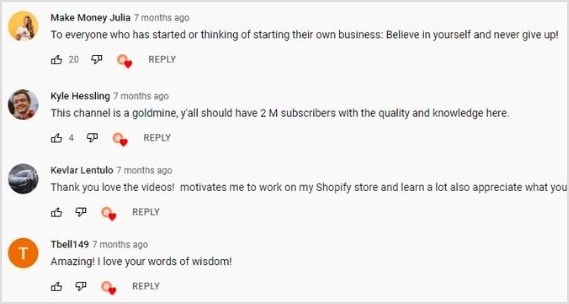
iii) Reply to a Bunch of Comments
Replying to the comments shows that you care about your subscribers. If you could solve a problem through your comment’s reply, it might make someone’s day.
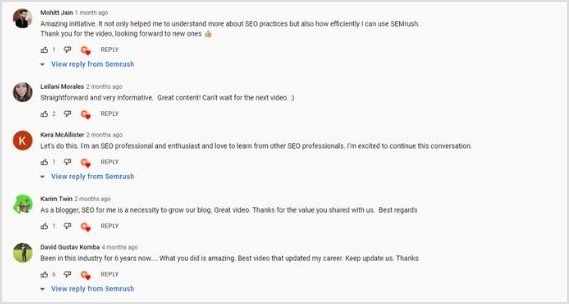
Don’t ever think that replying to the comments is a waste of time. Remember that these people cared enough to leave a comment so you got to treat them better.
iv) Run a Giveaway or a Contest
One of the best ways to increase engagement on a YouTube channel is by running a giveaway or a contest. Everyone wants free stuff and that’s the beauty of the giving stuff away. People don’t just watch the giveaway videos, but they’d also share or try to do whatever you ask them to do, for instance, leaving a comment or sharing the video, etc.
So try giving away some useful stuff that your audience might be interested in or would be flattered to get it. Brands often give away their products to a few lucky winners. If a product or a subscription costs $300 dollars, and the brand is giving away three subscriptions for free in a giveaway, chances are, a lot of people would be interested in winning the giveaway contest.
v) Ask Questions to the Audience
One of the hacks to increase the engagement on YouTube is by asking questions in your videos. YouTubers often ask questions at the end of their videos. It’s a tried-and-test strategy to get more comments, which leads to better engagement.
These were the engagement tactics that help brands spice up their YouTube strategy.
Don’t neglect the engagement with the viewers even if you’re getting a handsome amount of views and subscribers regularly. The engagement tactics would only bring better results.
The folks at Authority Hacker know about this too. Gael and Mark often ask questions to the audience. In one of their podcast episodes, they asked about the format of the show and encouraged the viewers to let them know via comments.
In the next step, I’ll talk about how you can build connections with other YouTubers, especially how it can boost your YouTube channel growth.
6. Collaborate with Similar Channels
A YouTube strategy for brands or a YouTuber is never completed without collaborations. Even YouTube encourages creators to collaborate with other YouTubers to grow on the platform.

Some of you might think that you don’t have connections on YouTube or maybe you don’t have enough following to collaborate with other YouTubers.
Let me clarify this: numbers aren’t the issue here; it doesn’t matter how many subscribers you have because whatever your number is, chances are, there are millions of creators who have similar numbers.
However, what you should be concerned about is that what value proposition you have in your video content that could compel people to build a connection with you and end up collaborating in the future.
Once you’ve built a “value proposition” or a “thing” that differentiates you from the rest of the tribe, not only would you get some attention, but you would also receive invitations to collaborate.
If you’re having a hard time understanding what building a connection means, then let me explain this: building a connection means you develop a relationship with an audience or a creator through engagement on social media that makes you stand out from the crowd.
So here are three benefits of collaboration on YouTube:
i) Cross-Promotes Each Other
When two or more creators collaborate with each other, they cross-promote each other in their videos, which helps everyone involved grow on the platform. Some beginners keep on asking for shout outs to fellow creators, and that’s the wrong approach. Instead, they should build a connection with the creators and look out for collaborations in the future.
ii) Diversifies the Audience
When creators collaborate on YouTube, the collaboration takes them in front of a new audience. It helps YouTube creators diversify their audience through other creators.
iii) The Audience Gets to Meet New Creators
When you collaborate with other creators, you present a different creator to your audience and that might be new to them. The loyal audience is always excited to meet the creators their favorite creators admire or happy to work with. So don’t shy away from doing YouTube collaborations with the right creators.
So these were three perks of doing collaborations on YouTube.
If you follow top YouTubers and influencers, they always collaborate with other creators because they use every single growth tactic out there to get more attention and grow on the platform.
Brands need to include collaborations in their YouTube strategy; they could collaborate with social media influencers, authors, pro-bloggers, and industry-experts.
Just make sure that you’re delivering value as a result of the collaboration.
7. Promote Across Multiple Platforms
A YouTube strategy that is built on just creating content might not be effective and long term. The reason is that if there is no promotional strategy integrated into your content marketing, it won’t reach the maximum audience. Hence it’s necessary to have a promotional strategy into the content mix even for YouTube channels.
Have you ever heard of 80/20 rule in content creation? It works for almost every type of content creator whether it’s blogging or YouTube. What 80/20 rule means is that one should spend 20 percent of the time on creating content and 80 percent of the time on promoting it.
You can use ContentStudio for scheduling your social media posts, but the irony is that scheduling your YouTube video links on social media isn’t enough; you got to have a plan to look further into content promotion.
I have a few ideas in mind that I can share with you for your YouTube channel growth.
People already know about sharing videos on Facebook, LinkedIn, and Twitter, but the problem is that most of them do it the wrong way. I’m talking about every platform that is accessible to you and you can use that to bring eyeballs to your YouTube content.
Here are three ways to promote your YouTube videos across multiple platforms:
i) Share videos on your social media accounts
Sharing videos on social media doesn’t mean simply paste the YouTube video’s URL and walk away. That’s what the newbies do and they don’t get anywhere. What you might want to do is use an image (or the video’s thumbnail) and write a brief text-based description for Facebook, Twitter, and LinkedIn to post along with the video URL.
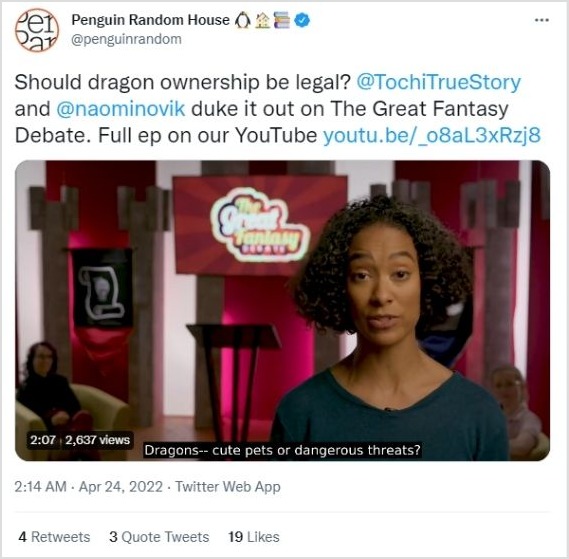
Sharing standalone URLs in the social media post doesn’t get any attention; people find such sharing as spamming unless you give them a reason to check out the link. So creating a custom social media post for each of your videos goes a long way.
ii) Embed YouTube videos in your articles
Have you ever embedded your YouTube video into your articles? I reckon most of you haven’t done it before. I have been doing for a while, and I can’t say that it brings thousands of extra views to every video, but it sure does make a difference.
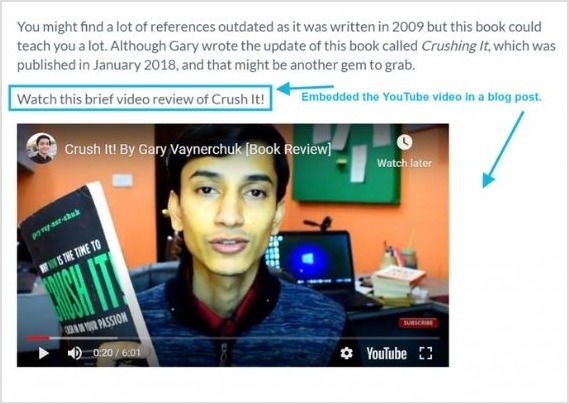
I don’t embed my videos into articles for the views, but instead, I do for the YouTube ranking. When a video is being clicked from outside the YouTube and brings the viewer to the YouTube platform, it’s considered a valuable piece of content, and chances are, YouTube might push the video to more audiences for more engagement and retention.
Suppose it doesn’t make a major impact, but it’s still a win-win situation if you earn a few YouTube subscribers through your blog.
iii) Insert videos into your email newsletters
A lot of you might not be building an email list, which is a huge mistake. And the rest of you might not be sending enough emails to your subscribers. You got to keep your email list engaged and alive.
As far as the YouTube strategy for brands is concerned, you can leverage your email list to promote your videos. This way, you’d have a chance to get some extra views and subscribers as well.
Some promotional tactics don’t seem to be effective until you land a client through that promotional channel.
So don’t underestimate any legit promotional opportunity available to you.
Let’s Conclude This
I covered every major step from target audience identification to developing a promotional strategy, which I truly believe can help any brand who wants to make the most of their YouTube existence.
A brand shouldn’t build a YouTube strategy based on a number of videos to try out the platform, for instance, 10 videos just to see how it works for them. Instead, they should focus on the value they can bring to the prospective audience.
If you don’t know what your audience is searching for or wants to know, then it’s your fault; do a little due diligence to fix this.
Most successful YouTubers didn’t grow their channel in the first attempt; they failed miserably in the beginning. Some of them kept on trying and suddenly got a hit video that changed everything. Others kept on trying different types of YouTube channels and then they hit a jackpot.
So YouTube’s success essentially relies on consistency and passion. If you’re a brand that isn’t excited to help out the audience through your knowledge, product, and expertise, then it might not work for you.
Read More: Everything You Need to Know About YouTube Video Requirements
